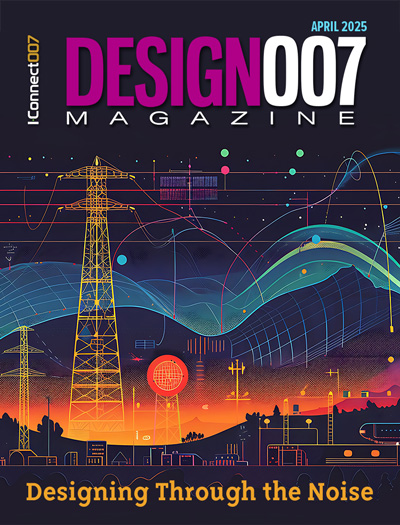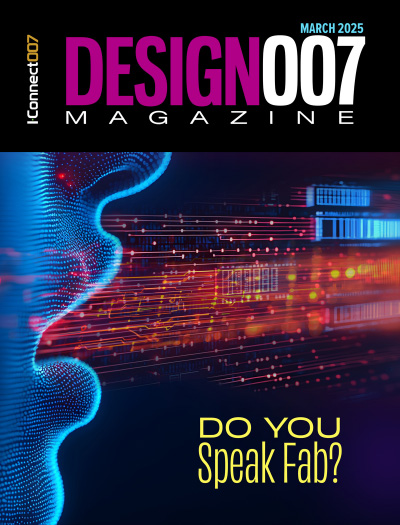-

- News
- Books
Featured Books
- design007 Magazine
Latest Issues
Current Issue
Designing Through the Noise
Our experts discuss the constantly evolving world of RF design, including the many tradeoffs, material considerations, and design tips and techniques that designers and design engineers need to know to succeed in this high-frequency realm.

Learning to Speak ‘Fab’
Our expert contributors clear up many of the miscommunication problems between PCB designers and their fab and assembly stakeholders. As you will see, a little extra planning early in the design cycle can go a long way toward maintaining open lines of communication with the fab and assembly folks.

Training New Designers
Where will we find the next generation of PCB designers and design engineers? Once we locate them, how will we train and educate them? What will PCB designers of the future need to master to deal with tomorrow’s technology?
- Articles
- Columns
Search Console
- Links
- Media kit
||| MENU - design007 Magazine
Altium Designer 19.0 Features Printed Electronics Design Functions
August 8, 2019 | Andy Shaughnessy, Design007 MagazineEstimated reading time: 2 minutes
The newest version of Altium Designer—revision 19.0—includes functionality for designing printed electronic circuits. We wanted to get the scoop on Altium’s PEC tools, so we asked Nikolay Ponomarenko, Altium’s director of product management, to give us a tour of the new functions.
Andy Shaughnessy: Nikolay, tell us about the printed electronics design capabilities in the newest version of Altium Designer. I’ve heard good things about it.
Nikolay Ponomarenko: Starting with AD 19.0, we have added a set of capabilities targeting the design of non-conventional boards. One of these is printed with conductive ink in a semi-additive style without traditional etching of the solid copper planes.
Altium Designer users can now design a stackup with all of the specifics of the processes of printed electronics, which takes into consideration the passes of the conductive or non-conductive material deposition; internally, we refer to this as layerless stackup.
As part of that process, designers can define explicit dielectric layers (i.e., the layers where dielectric might be represented by some geometry) instead of the assumed solid as seen in traditional boards. For each of the printing passes (“layers”), you can explicitly define the ink material.
Connectivity between conductive layers assumes the physical connection of the printed materials in Z-axis. For example, part of the trace might consist of segments printed with different inks or it takes multiple passes to reach the desired thickness of the feature.
When such connectivity is not desirable, the designer can simply build the dielectric crossovers, isolating different nets when they need to jump over each other using a manual or automated approach.
To control the shorts and connectivity, the rules and constraints system was adjusted and acknowledges the uniqueness of the Z-axis connectivity of the printed designs.
Shaughnessy: What were some of the drivers that led you all to develop PEC design functions?
Ponomarenko: Altium has always been a leader of innovation in the EDA software industry, and we see printed electronics as one of the emerging niches in the market. We want to ensure our users can stay up to date and are not limited by the tool to move forward with their products—that was the key motivation. We have been working with an excellent partner, Tactotek, to create design capabilities and parameters for printed electronics. They make production scale injection molded structural electronics (IMSE).
To read this entire interview, which appeared in the July 2019 issue of Design007 Magazine, click here.
Suggested Items
I-Connect007 Editor’s Choice: Five Must-Reads for the Week
04/25/2025 | Nolan Johnson, I-Connect007I’m highlighting a discussion on the positive potential coming from the recent changes in global trade policy—from IPC’s Government Relations team, and from TTM CEO Tom Edman. In the realm of designers and purchasers realm, there’s news from Screaming Circuits and ASC/Sunstone Circuits to share. Finally, additive manufacturing and the release of CFX 2.0 highlight just some of the news coming to the shop floor as well.
KYZEN Focuses on Aqueous Cleaning and Stencil Cleaning at SMTA Wisconsin
04/24/2025 | KYZEN'KYZEN, the global leader in innovative environmentally responsible cleaning chemistries, will exhibit at the SMTA Wisconsin Expo and Tech Forum, scheduled to take place Tuesday, May 6 at the Crowne Plaza Milwaukee Airport. KYZEN will be on-site to provide attendees with information about aqueous cleaning chemistry AQUANOX A4618 and stencil cleaner KYZEN E5631J.
TRI at SMTA Wisconsin Expo 2025
04/24/2025 | TRITest Research, Inc. (TRI), the leading test and inspection systems provider for the electronics manufacturing industry, will join the SMTA Wisconsin Expo 2025.
Real Time with... IPC APEX EXPO 2025: Empowering IPC North Asia—Leadership and Future Goals
04/24/2025 | Real Time with...IPC APEX EXPONolan Johnson catches up with Sydney Xiao, the IPC North Asia President, who leads a team covering China, Taiwan, Japan, and Korea. IPC's North Asia regions 800 members are focusing on standards, training, and advocacy to enhance quality and profitability. The adoption of IPC standards by Toyota in 2021 highlights this increased regional engagement. IPC prioritizes workforce development, with over 7,000 professionals in certification programs and school partnerships.
Real Time with... IPC APEX EXPO 2025: IPC's Growth and Future in India's Manufacturing Sector
04/23/2025 | Real Time with...IPC APEX EXPOGaurab Majumdar, VP for IPC in SE Asia and India, highlights IPC's impressive growth in India, with certification numbers rising significantly. The Indian manufacturing sector is projected to reach a $300 billion market, alongside a $10 billion investment in semiconductors. IPC is addressing industry demands through standards development and a new workforce project aimed at training students for job placements.


